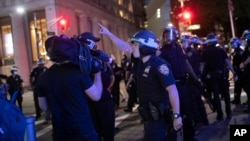Andrew Buncombe expected his assignment on July 1 to be relatively straightforward: covering the clearing of a Seattle protest site for the British daily The Independent. Instead, the reporter found himself in a situation he had never experienced before.
Irons were strapped to his ankles and a chain wrapped around his stomach. He was in a van heading toward Seattle’s West Precinct, in close quarters with others who, like Buncombe, had just been arrested.
At one point, the “belly chain” became so tight that he told the officers he could not breathe — a phrase similar to the words spoken by George Floyd, Eric Garner and other Black Americans who died while in police custody, and one that has become a rallying cry in Black Lives Matter demonstrations.
In response, an officer told him “If you can speak, you can breathe,” Buncombe said.
“It felt surreal and it felt crazy and just ridiculous that I would have to use those words to an officer who just arrested me,” Buncombe told VOA. “Their response to me speaks for itself.”
The Seattle police did not respond to VOA’s emails requesting comment.
The Office of Police Accountability and King County sheriff’s department, which covers Seattle, were reviewing details of the journalist’s arrest, Buncombe’s newspaper reported.
Buncombe is one of more than 70 journalists arrested while covering demonstrations sparked by the May 25 death of Floyd in Minneapolis.
The U.S. Press Freedom Tracker has received reports on over 500 incidents involving journalists, including 114 attacks. Advocates say the incidents could have dangerous implications for press freedom in the U.S.
“There's no comparison because never before, certainly in modern history and certainly in the Tracker’s history, have there been simultaneous protests happening at one time,” Kirstin McCudden, the Tracker’s managing editor, said referring to the U.S.
'Window of insight'
Buncombe, The Independent’s Chief U.S. Correspondent, was reporting from Cal Anderson Park on the clearing of the Capitol Hill Organized Protest, an area protesters declared autonomous for over three weeks.
Within five minutes of arriving at the park, Buncombe said, police told him he was in an “out of bounds location” and arrested him. He said he held up press pass and told them he intended to take photographs.
Reporters are exempt from dispersal orders unless they are physically obstructing efforts by police, according to the Seattle Municipal Code.
Buncombe was in police custody with 10 others, most of whom were protesters, and said he was anxious about contracting the coronavirus. He said he told officers he was a journalist.
After about six hours, police told the journalist he would be charged with “failure to disperse,” and he was released. On July 15, the charges were dropped.
Buncombe said the incident was not close to the worst treatment that people and other journalists have experienced. But, he said, it did shed light on the criminal justice system.
“It was just this tiny, tiny, tiny window of insight into the system,” he said. “You can shout and scream, and you can hold up your press pass and say ‘I'm innocent. I haven’t done this. I've done nothing wrong. I'm not a protester.’ Until they've kind of dealt with you, until you've gone through the process, you might as well just sit there and be quiet.”
New trend
The start of protests marks the most incidents documented by the Press Freedom Tracker since it was created in 2017, McCudden said. On average, the tracker reported about 150 incidents annually.
McCudden has noticed several trends, including the role law enforcement has played. Of the 114 reported physical attacks, a law enforcement officer was the alleged assailant in 68 of them — about 60 percent.
Last year, she said, 39 journalists were attacked, six allegedly by law enforcement.
“Instead of providing and creating an environment where both demonstrators and journalists can exercise the right to demonstrate and cover the news, [they] are confronted in highly aggressive methods. For us, that's a very concerning trend,” Carlos Martínez de la Serna, the program director for the Committee to Protect Journalists (CPJ), told VOA.
CPJ helps the Tracker with its reporting.
Many of the arrests and attacks took place after the journalists identified themselves and offered to change locations, Martínez de la Serna said.
Press freedom advocates worry that the incidents will damage the country’s previous standing as a beacon of press freedom globally.
The U.S. has experienced a steady decline in press freedom, even before this year. In Reporters Without Borders’ 2020 World Press Freedom Index, the U.S. ranked 45 out of 180 countries, with 1 being most free. The country has declined by 13 spots since 2013.
“I am absolutely concerned about the state of press freedom in the United States,” Nora Benavidez, the director of U.S. Free Expression Programs at PEN America, told VOA. “Much of our work now is trying to acclimate people to understanding that press freedom is not an abstract concept. It is a fundamental aspect of our democracy.”
Others said the public nature of the incidents could hinder other countries’ perception of the U.S.
“It's the images of journalists being attacked and violence against demonstrators across 71 cities, across the whole U.S,” Martínez de la Serna said. “That's on top of a lack of leadership in terms of press freedom.”
Advocates say change and justice is needed including consequences for those involved in incidents with journalists.
Press freedom groups, including the CPJ, have called on U.S. governors and President Donald Trump to ensure the attacks are fully investigated and to respect the right of journalists to cover protests.
In addition, rights groups are pushing for a reduction in anti-press sentiments nationwide.
“People need credible information, and that really does start with journalists,” Benavidez said. “They need to have the latitude and the freedom to be able to report as they wish, and to be free from retaliation.”




